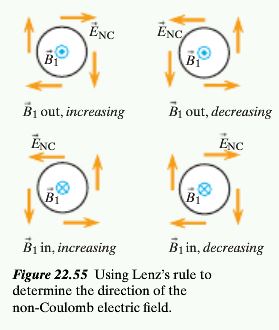Lenz's Rule
Claimed by Quinn Witsken
This page will explain how to determine the non-Coulumb Electric Field using Lenz's Rule.
The Main Idea
As we all know, it can often be very difficult to determine the direction of the non-Coulumb Electric Field at a location due to so many factors and thumb rules and such. The most common way to determine the direction of E(NC) is to point your thumb in the direction of -dB/dt. That can, however, be quite difficult to understand and conceptualize. The other way to determine it is using Lenz's Rule. Imagine placing a wire over the changing Flux, so that the conventional current runs in the direction of E(NC). This current would make it so that a magnetic field is created in the opposite direction of dB/dt. This means that the additional magnetic field attempts to keep the original magnetic flux constant. It does not succeed however, unless the wire was a perfect conductor. This helps you visualize that the magnetic field tries to balance out the first one, and you can use the right hand rule to try and visualize which way the electric field would be going to create a current in that direction.
It also gives the correct direction of current in the case of motional emf. It is very very easy to make conceptual mistakes with Lenz's rule to make sure you really understand it before attempting to use it.
A Mathematical Model
The beauty of this Rule is that there is absolutely no math involved. The only thing you need to use is the right hand rule, which is where you wrap your fingers in the direction of the conventional current and the way your thumb points is the direction of the magnetic field produced. After that, it's just imagining that magnetic field balance out the original one. It's a great way to conceptualize a difficult concept.
Examples
Middling
Use these for pictures to determine which way the E(NC) is going, using both the Lenz's Rule and the right hand rule with -dB/dt.

Connectedness
- How is this topic connected to something that you are interested in?
Solenoids are incredible interesting to me. They have many applications, but one of the more interesting ones is a automotive gearbox. As a car enthusiast, and was very interested in how gearboxes work and how solenoids are applied. But a solenoid is pretty much an electromagnet, which are pretty cool.
- How is it connected to your major?
My major is Mechanical Engineering. Again, that leads me to be very interested in cars, which, as I mentioned before, have many useful applications for solenoids. They can also be used in car air conditioning controls, entertainment release mechanisms, and security systems. In fact, the solenoid is also a key component in some joystick controls designed for games that simulate the driving experience.
- Is there an interesting industrial application?
Solenoids are very prominent in industrial applications that require air or water flow. This is because they can be used to actuate valves, and they can also lock, pinch, and hold things.
History
Lenz's law is named after German Scientist Heinrich Lenz, and it says: "If an induced current flows, its direction is always such that it will oppose the change which produced it".
This law was discovered in 1834.
See also
External links
http://www.infoplease.com/encyclopedia/science/lenz-law.html
http://www.professionaldude.com/?solenoid-applications-in-the-modern-world,9
https://en.wikipedia.org/wiki/Lenz%27s_law
References
Infoplease. Infoplease. Web. 4 Dec. 2015.
"Solenoid Applications in the Modern World." Solenoid Applications in the Modern World. Web. 4 Dec. 2015.
Schmitt, Ron. Electromagnetics explained. 2002. Retrieved 16 July 2010.